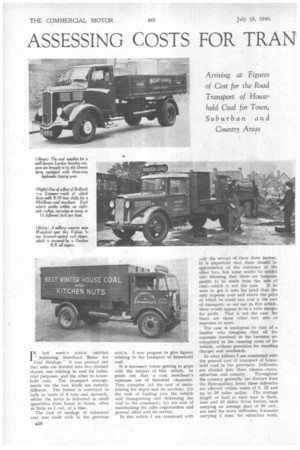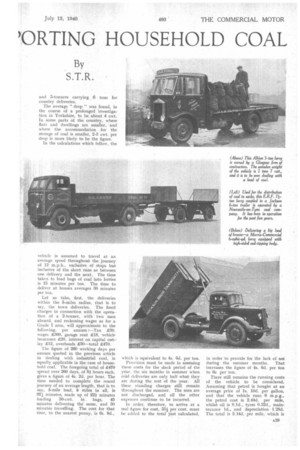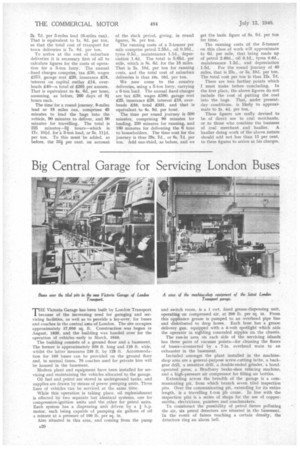ASSESSING COSTS FOR TRAN 'ORTING HOUSEHOLD COAL
Page 20

Page 21

Page 22

If you've noticed an error in this article please click here to report it so we can fix it.
I N last week's article, entitled 'Achieving Stabilized Rates for Coal Haulage " it was pointed out that sales are divided into two distinct classes, one relating to coal for industrial purposes, and the other to household coal. The transport arrangements for the two kinds are entirely different. The former is conveyed in bulk in loads of 4 tons and upwards, whilst the latter is delivered in small quantities from house to house, often as little as 1 cwt, at a time.
The cost of haulage of inJustrial coal was dealt with in the previous article. I now propose to give figures relating to the transport of household coal.
It is necessary before getting to grips with the subject of this article, to point out that a coal merchant's expenses are of threefold character. They comprise (a) the cost of maintaining his depot and its services; (b) the cost of loading into the vehicle and transporting and delivering the coal to the consumer; (a) the cost of maintaining the sales organization and general office and its service.
In this article I am concerned with ty the second of these three factors. It is important that there should be appreciation of the existence of the other two, lest some reader be misled into thinking that there are immense profits to be made from the sale of coal—which is not the case. If be were to get it into his head that the only expense over and above the price at which he could buy coal is the cost of transport, as set out in this article. there would appear to be a wide margin for profit. That is not the case, for there are these other two sets oi expenses to meet.
The case is analogous to that of a haulier who imagines that all the expenses involved in his business are comprised in the running costs of his vehicle, without provision for standing charges and overheads.
In what follows I am concerned with the general cost of transport of household coal, in the provinces. Deliveries are divided into three classes—town,
suburban and country. Throughout the country generally (as distinct from the Metropolitan Area) these deliveries are effected within zones of 5, 12 and up to 30 miles radius. The average length of lead in each case is three, nine and 23 Miles; 2-ton lorries, each carrying an average load of 30 cwt., are used for town deliveries, 3-tonners carrying 3 tons, for suburban work,
and 5-tonners carrying 6 tons for country deliveries.
The average " drop " was found, in the course of a prolonged investigation in Yorkshire, to be about 4 cwt. In some parts of the country, where flats and dwellings are smaller, and where the accommodation for the storage of coal is smaller, 2-3 cwt. per drop is more likely to be the figure.
In the calculations which follow, the vehicle is assumed to travel at an average speed throughout the journey of 12 m.p.h., exclusive of stops but inclusive of the short runs as between one delivery and the next. The time taken to load bags of coal into lorries is 15 minutes per ton. The time to deliver at houses averages 30 minutes per ton.
Let us take, first, the deliveries within the 5-miles radius, that is to say, the town deliveries. The fixed charges in connection with the operation of a 2-tonner, with two men aboard, and reckoning wages as for a Grade I area, will approximate to the following, per annum :—Tax £30, wages £360, garage rent £18, •vehicle insurance £20, interest on capital outlay £12, overheads £30—total £470.
The figure of 260 working days per annum quoted in the previous article in dealing with industrial coal, is equally applicable in the case of household coal. The foregoing total of £470 spread over 260 days, of 84 hours each, gives a figure of 4s. 2d. per hour. The time needed to complete the round journey of an average length, that is to say, 3-mile lead, 6 miles in all, is 971 minutes, made up of Z24 minutes loading 30-cwt. in bags, 45 minutes delivering the same, and 30 minutes travelling. The cost for that time, to the nearest penny, is Os. 9d.,
which is equivalent to 4s. 6d. per ton.
Provision must be made in assessing these costs for the slack period of the year. the six months in summer when cdal deliveries are only half what they are during the rest of the year. All these standing charges still remain throughout the summer. The men are not discharged, and all the other expenses continue to be incurred.
In order, therefore, to arrive at a real figure for cost, 331 per cent, must be added to the total just calculated, in order to provide for the lack of use during the summer months. That increases the figure of 4s. 6d. per ton to 6s per ton.
There still remains the running costs of the vehicle, to be considered. Assuming that petrol is bought at an average price of is. 10d. per gallon, and that the vehicle runs 9 m.p.g., the petrol cost is 2.44d. per mile, whilst oil is 0.1d., tyres 0.32d., mainterance id, and depreciation 1.28d. The total is 5.14d. per mile, which is 2s. 7d. per 3-miles lead (6-miles run). That is equivalent to Is. 8d. per ton, so that the total cost of transport for town deliveries is 7s. 8d. per ton. To arrive at the cost of suburban deliveries it is necessary first of all to calculate figures for the costs of operation for a 3-ton lorry. The annual • fixed charges comprise, tax £30, wages £373, garage rent £20, insurance £24. interest on capital outlay £14, overheads £40-a total of £501 per annum. That is equivalent to 4s. 6d, per hour, assuming, as before, 260 days of 8i hours each.
The time for a round journey, 9-miles lead or 18 miles run, comprises 45 minutes to load the bags into the vehicle, 90 minutes to deliver, and 90 minutes for travelling. The total is 225 minutes-31 hours-which is 17s. 104d. for .a. 3-tori load, or 5s. 11id. per ton. To this must be added, as before, the 34 per cent. on account
of the slack period, giving, in round figures, 8s. per ton. The running costs of a 3-tonner per mile comprise petrol 2.55d., oil 0.10d., tyres 0.5d., maintenance 1.1d., depreciation 1.4c1. The total is 5.65d. per mile, which is 8s. 6d, for the 18 miles. That is 2s, 10d. per ton for running costs, and the total cost of suburban deliveries is thus 10s. 10d. per ton.
We now come to the country deliveries, using a 5-ton lorry, carrying a 6-ton load. The annual fixed charges are tax £30, wages £380, garage rent £25, insurance £28, interest £18, overheads 250, total £531, and that is equivalent to 4s. 9d. per hour.
The time per round journey is 500 minutes, comprising 90 minutes for loading, 230 minutes for running, and 180 minutes for delivering the 6 tons to householders. The time cost for the journey is thus 39s. 7d., or 6s. 7d. per ton. Add one-third, as before, and we get the basic figure of 8s. 9d. per tun for time.
The running costs of the 5-tonner on this class of work will approximate to 6d. per mile, that being made up of petrol 2.60d.; oil Old., tyres 0.6d., maintenance 1.2d., and depreciation 1.5d, For the round journey of 46 miles, that is 23s., or 3s. 10d. per ton. The•total cost per ton is thus 12s. 7d. There are two further points which I must make before concluding. In the first place, the above figures do not include the cost of putting the coal into the bags. That, under presentday conditions, is likely to approximate to 2s. 4d. per ton.
These figures are really devised to be of direct use to coal merchants, or to those who combine the business of coal merchant and haulier. A haulier doing work of the above nature should add not less than 15 per cent. to these figures to arrive at his charges.




















































